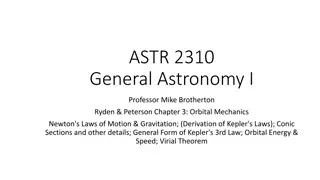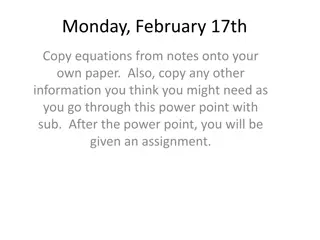Newton's Laws of Motion and Law of Universal Gravitation
Isaac Newton, a giant in scientific history, revolutionized physics with his three laws of motion and law of universal gravitation. His laws of inertia, force, and action and reaction explain the behavior of objects in motion, while the law of gravitation describes the force that governs celestial b
7 views • 10 slides
Newton's Law of Universal Gravitation
Newton's Law of Universal Gravitation explains how gravitational force between two objects is influenced by their masses and the distance between them, following an inverse square relationship. This law, expressed by the formula F=Gm1m2/r^2, helps understand various phenomena such as planetary motio
1 views • 26 slides
Gravity: The Force that Shapes Our Universe
Sir Isaac Newton's discovery of gravity revolutionized our understanding of the universe, explaining the force that keeps us grounded on Earth and governs the motion of celestial bodies. Gravity, as described by the Law of Universal Gravitation, is an attractive force that acts between all objects i
3 views • 19 slides
Newton's Law of Universal Gravitation
Newton's Law of Universal Gravitation explores the concept of gravity, how it affects different bodies in space, and the relationship between mass, distance, and gravitational force. Newton's pioneering work in this area laid the foundation for understanding the forces that govern the movement of pl
1 views • 22 slides
Gravity: Why Things Fall and Weight on Earth Explained
Delve into the concept of gravity and its role in keeping objects on the ground, causing things to fall, and determining weight. Explore how mass, distance, and Newton's law of universal gravitation shape our understanding of this fundamental force.
5 views • 8 slides
Isaac Newton: Contributions to Mathematics and Physics
Isaac Newton, a renowned physicist and mathematician from England, was the greatest scientist of his era. Despite being described as 'idle' and 'inattentive' in school, he formulated the Three Laws of Motion and the law of Universal Gravitation. Newton's mathematical contributions include studying p
4 views • 16 slides
Orbital Dynamics: From Newton's Laws to Kepler's Laws
Exploring the fascinating realm of orbital dynamics, this content delves into the application of Newton's laws to explain Kepler's laws and the intricacies of orbital mechanics. Deriving Kepler's laws from Newton's law of gravitation involves advanced mathematics, while also emphasizing the signific
2 views • 25 slides
Newton's Law of Gravitation and Kepler's Laws of Planetary Motion
Explore the gravitational constant, force of attraction between objects, and equations for calculating gravitational force and centripetal force. Delve into Kepler's laws describing planetary orbits. Uncover the relationship between periods and distances of planets from the sun.
3 views • 9 slides
Physics Concepts Review: Motion and Forces
Explore essential concepts in physics related to motion and forces, including forces acting against falling objects, gravitational forces, momentum, inertia, and more. Test your knowledge with questions on gravity, air resistance, satellite orbits, and the law of universal gravitation.
2 views • 17 slides
Forces on and in the Human Body
Newton's law of universal gravitation explains the gravitational force that affects our weight and other bodily functions. Electrical forces play a crucial role in muscle control and cell functions, while nuclear forces keep protons together in the nucleus. These forces have significant impacts on o
2 views • 35 slides
Circular Motion Revision for AQA Syllabus
Circular motion involves experiencing a centripetal force leading to acceleration toward the center of a circle. Understanding angular speed, centripetal force, and the equations associated with circular motion are crucial for a comprehensive comprehension of this topic. An example problem and Newto
3 views • 26 slides
Universal Gravitation and Planetary Motion
Explore the principles of Newton's Law of Universal Gravitation and Kepler's Laws of Planetary Motion. Delve into the concept of gravitational attraction between celestial bodies and the validation of these laws through the conservation of angular momentum. Learn about the measurement of the gravita
7 views • 20 slides
Project STARS: Enhancing Astronomy Education in Schools
Explore the Project STARS initiative funded by the Erasmus+ Programme, focusing on teaching astronomy in schools. This project offers training programs, methodological handbooks, online platforms, and modules covering topics like celestial bodies' motion, Newton's law of gravitation, and more. Teach
0 views • 16 slides
Newton's Universal Law of Gravitation with Real Astronomical Data
Explore the application of Newton's Universal Law of Gravitation using real astronomical data in an inquiry-driven approach. Learn about NGSS requirements, modeling pedagogy, and the relationship between mass, weight, and gravitational intensity. Engage in student-centered activities to develop a qu
14 views • 19 slides
Circular Motion and Gravitation
Exploring the concepts of circular motion and gravitation, this content delves into the kinematics, centripetal acceleration, velocity, period, and frequency of objects in circular motion. Through examples and explanations, it simplifies the understanding of centripetal acceleration and provides ins
4 views • 25 slides
Non-Riemannian Geometry and Born-Infeld Models in Gravitational Theory
In this paper by Diego Julio Cirilo-Lombardo, a non-Riemannian generalization of the Born-Infeld Lagrangian is introduced in the context of gravitation with a dynamical torsion field. The resulting field equations lead to a trace-free gravitational equation and provide insights into primordial magne
2 views • 34 slides
Strategy Analysis for ASEAN Mega FTAs
Delve into the complexities of ASEAN's engagement in Mega FTAs, focusing on market gravitation comparison and trade rules with a strategic approach to navigate the evolving global economic landscape. Explore the dynamics of new market access and rules for 21st-century trade within the ASEAN region a
2 views • 17 slides
Newton's Law of Universal Gravitation
Newton's Law of Universal Gravitation explains how every object in the universe attracts each other with a force proportional to their masses and inversely proportional to the square of the distance between them. This fundamental law, defined by the equation F = G * (m1 * m2) / r^2, has been pivotal
2 views • 17 slides
Dynamics of Uniform Circular Motion
Exploring the concept of uniform circular motion, this content delves into the centripetal force required to keep an object moving at a constant speed along a circular path. It discusses the relationship between centripetal force, speed, radius, and mass in maintaining circular motion. Various examp
11 views • 13 slides
Calculating Weight of Gymnast Suspended by Ropes
The figure shows a gymnast suspended by his arms at the end of two ropes with tensions of 4.1 x 10^2 N each at an angle of 65 degrees. By applying principles of gravitational fields and Newton's law of gravitation, we can calculate the weight of the gymnast. The gravitational constant is utilized to
0 views • 18 slides
Universal Law of Gravitation in Physics
Explore the concept of Universal Law of Gravitation in Physics, including gravitational force, gravitational attraction between objects, and gravitational field strength. Learn to calculate these values with equations and examples showcasing the fundamental principles of gravity.
1 views • 9 slides
Universal Gravitation: The Force of Gravity Explained
Gravity is a fundamental force present in all matter, governed by the Law of Universal Gravitation. This law explains how objects exert forces on each other based on their masses and distances. Gravitational forces influence celestial bodies, orbits, and human experiences like microgravity. Learn ab
4 views • 20 slides
Gravity and Inverse Square Relationships in Physics
Explore the concepts of gravitational field, potential, geostationary orbits, escape velocity, and the inverse square relationship in Newton's Law of Universal Gravitation. Discover how mass and distance affect gravitational force and learn about nonuniform gravitational fields and equipotential lin
16 views • 22 slides
Gravity: The Laws of Motion
Gravity is the attractive force between objects, influenced by mass and distance. Newton's Law of Universal Gravitation explains this force, affecting everything from falling objects to planetary orbits. Mass and acceleration play key roles in gravitational interactions, shaping our understanding of
3 views • 9 slides
PHYS 1443 Section 003 Lecture: Newton's Laws and Circular Motion Homework
Dive into the world of physics with Dr. Jae Jaehoon Yu as he covers Newton's Laws of Motion, motion with friction, circular motion, and gravitation. Stay on track with homework #7 due on March 30, and prepare for the mid-term exam. Explore kinematics and dynamics of uniform circular motion, Newton's
2 views • 17 slides
Dynamics of Uniform Circular Motion & Centripetal Force Explained
Explore the concept of uniform circular motion, the need for centripetal force to keep objects on a circular path, problem-solving techniques, and real-world applications like banked curves and gravitational attraction. Understand Newton's Law of Universal Gravitation and the Universal Gravitational
1 views • 13 slides
Newton's Laws and Gravitation Principles
Explore Isaac Newton's three laws of motion and the universal law of gravitation. Learn about concepts such as momentum, the relationship between force and acceleration, and the gravitational force between objects. Discover the relevance of these principles in various scenarios, from orbital mechani
3 views • 10 slides
Orbital Dynamics & Kepler's Laws: Explained Through Newton's Theory
Orbital dynamics and Kepler's laws are elucidated using Newton's theory of gravitation and motion, revealing the intricacies of orbital mechanics. Explore the derivation of Kepler's laws, orbital energy, speed, and more with insightful details on conic sections. Angular momentum, orbital energetics,
2 views • 6 slides
Orbital Mechanics & Kepler's Laws: Understanding Orbital Dynamics
In this study of orbital mechanics, delve into Newton's laws of motion and gravitation to explore the derivation of Kepler's laws, along with insights on conic sections, Kepler's 3rd law, orbital energy, and more. Discover how angular momentum and orbital energetics play pivotal roles in determining
3 views • 48 slides
Geophysical Prospecting Course at Salahaddin University Erbil
Explore the practical course program of the Earth Sciences and Petroleum Department at Salahaddin University Erbil, covering topics like Newton's law of gravitation, drift correction, gravity interpretation, magnetic corrections, and more. Grading includes mid-term exams, reports, quizzes, and activ
1 views • 7 slides
Centripetal Acceleration and Newton's Law in Physics
Explore the concepts of centripetal acceleration, unbanked and banked highways, Newton's Law of Universal Gravitation, and work and energy in physics. Get ready for quizzes and exams with important announcements, reading assignments, and special projects. Learn about forces in motion and their effec
1 views • 18 slides
Poisson Process Calculations and Astronomical Discoveries
Explore the fascinating world of Poisson process calculations and significant astronomical discoveries such as Michell's argument regarding gravitation and the Pleiades star cluster. Discover insights from historical figures like John Michell, Simon Newcomb, and more.
4 views • 16 slides
Exploring Gravitation Concepts in Class IX - Sainik School Gopalganj
Explore gravitational concepts like Newton's Universal Law of Gravitation, properties of gravitational force, and the gravitational force of the earth as explained by Dr. A.K. Choubey in the Class IX curriculum at Sainik School Gopalganj. Understand the basics of gravity, its effects on celestial bo
2 views • 42 slides
Mechanics in B.Sc. First Year Physics: Study of Motion by Dr. S. D. More
Explore the fundamentals of Mechanics, Elasticity, Viscosity, Ultrasonic Acoustics, and more in B.Sc. First Year Physics Semester-I. Delve into topics such as Newton's Law of Gravitation, Compound Pendulum, and Simple Pendulum. Enhance your understanding of gravitational forces, time periods, and si
17 views • 16 slides
Electricity & Gravitation Similarity Revealed
Explore the similarities between Coulomb's force in electricity and gravitational force, understanding the fundamental principles behind the interactions of charges and masses. Delve into the experiments by Charles Coulomb and the significance of Coulomb's law in modern research on contact electrifi
0 views • 5 slides
Understanding Gravitational Fields
Learn about gravitational fields and the universal law of gravitation, how vectors represent gravitational fields, the concept of gravitational field strength, and its significance in physics. Explore the relationship between massive objects, attractive forces, and the field's influence on space.
1 views • 9 slides



































